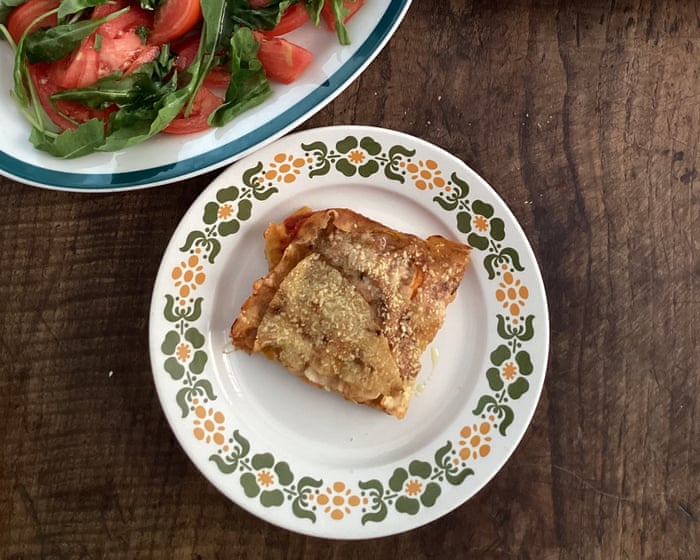Making Sardinian pane carasau is just as mesmerizing as making pita bread. A round of durum wheat dough bakes on a hot surface until it puffs up like a balloon. This happens because the dough’s surface dries quickly while the moisture inside turns to steam, forcing the center to rise and creating two thin layers with a pocket in between—almost like an inflated whoopee cushion.
To make pane carasau—a craft that ranges from homemade to artisanal to industrial in Sardinia—the puffed dough is quickly split into two thin discs with a sharp knife. These discs are then returned to the oven, sometimes folded in half or quarters, for a second bake to dry and crisp to the maker’s preference. Luckily, there are countless variations, and the beauty of pane carasau (also called “music paper bread”) is that it travels well and keeps for ages—which is why I always have some in my cupboard.
You can enjoy pane carasau in many ways: its crisp, cracker-like texture pairs perfectly with cheese, honey, or soft toppings. It can also be eaten like bread—filled, dipped into soups, or crumbled into salads. For a softer texture, briefly soak it in cold water or run it under the tap, making it pliable enough to fold or roll. It even works like pasta sheets for lasagna—inspired by La Cucina Italiana, I’ve made one with a rich tomato sauce (using both fresh and canned tomatoes), mozzarella (well-drained), and Parmesan. Some debate whether dry or slightly damp pane carasau works best, but I’ve found a mix is ideal: three dry layers topped with a final damp layer to prevent the top from drying out before the cheese melts and forms a golden crust.
Like classic lasagna, let it rest for about 20 minutes after baking so the flavors settle and the dish firms up. The beauty of pane carasau is that it holds its shape while remaining light and delicate—similar to handmade fresh pasta. Serve it in squares with a green salad and a glass of Sardinian red wine, like Bovale Sardo or Cannonau.
### Lasagna with Sardinian Pane Carasau
Serves 4
Ingredients:
– 500g ripe tomatoes
– 5 tbsp olive oil
– 2 garlic cloves, peeled and lightly crushed
– 400g tin whole plum tomatoes in juice
– 1 small red chilli (fresh or dried), whole or chopped for extra heat
– Salt
– 8 basil leaves
– 180g pane carasau (find it in Italian delis)
– 400g mozzarella, drained and diced
– 80g Parmesan, grated
Method:
1. Peel the fresh tomatoes by covering them with boiling water for 2 minutes, then cooling under cold water—the skins should slip off easily. Roughly chop, discarding any tough bits.
2. Heat the olive oil and garlic in a heavy pan over low heat until the garlic sizzles gently (don’t let it burn). Add both fresh and tinned tomatoes, bring to a lively simmer, and cook for 15 minutes.
3. Add the chilli and a pinch of salt, then reduce the heat and simmer gently for 45 minutes, breaking up the tomatoes with a wooden spoon. Stir in the basil for the last 10 minutes. The sauce should be thick and glossy, with oil pooling at the edges.
4. Assemble the lasagna in a 20cm x 26cm baking dish: start with a layer of sauce, then a layer of pane carasau (overlapping pieces are fine). Add another layer of sauce, mozzarella, and Parmesan. Repeat for three more layers, briefly wetting the final pane carasau layer under running water before topping with a thin smear of sauce and extra cheese.
5. Bake until golden and bubbly, then let rest for 20 minutes before serving.Sprinkle a layer of grated cheese on top. Bake at 175°C (165°C for fan ovens) or gas mark 3½ for 20 minutes until golden.
Correction: This article was updated on 31 July 2025. A previous version incorrectly stated that the flatbreads were layered with tomato and lasagne, when it should have said tomato and cheese.




